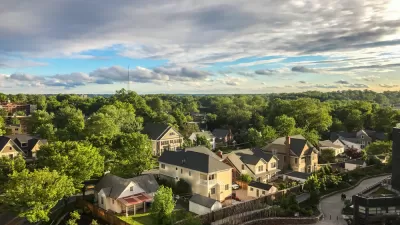Rent control is a popular response to the ongoing housing affordability crisis in many parts of the United States, but there is still a chorus of economists and planners who argue that rent control can do more harm than good to housing affordability.

Bill Lindeke writes for the twin cities sidewalks blog to make the case that the Housing Equity Now Saint Paul (HENS) rent control proposal, which would cap rent increases at 3 percent annually, would stop new housing from being built—a "de facto ban on housing," as it's described here.
Earlier this month, Lindeke reported for the MinnPost that St. Paul voters are faced with the prospect of approving the country's most aggressive rent control policy in the November election. To recap the summary of the HENS proposal provided in that article:
The law would cap rent increases for all of the city’s 65,000 rented homes at 3% per year, but includes a complicated list of factors that allow landlords to apply for a variances — things like property taxes, maintenance issues, capital improvements (only if needed to bring a building to code), and a few others. The process for applying for the variances is yet to be determined. The ordinance exempts only subsidized housing from the caps.
In the blog post for twin cities sidewalks, Lindeke explains that the question that keeps coming up since the MinnPost article is as follows: "Why does a 3% rent cap stop new housing from being built?"
Lindeke's answer, which you should click through below to read in full, hinges on
- The difference between landlords and developers: "3% is usually fine for a landlord but a huge limit for someone leasing out a new building."
- Inflation: "If inflation is close to or higher than 3%, you're just plain screwed. Not only can’t you move rents around to fill a building, you're actually forced to lower rents in real dollars."
The 3 percent cap on rent therefore, according to Lindeke, "greatly increases the risk of loans for new housing construction."
FULL STORY: Why the 3% Rent Cap Stops New Housing Construction

Planetizen Federal Action Tracker
A weekly monitor of how Trump’s orders and actions are impacting planners and planning in America.

Restaurant Patios Were a Pandemic Win — Why Were They so Hard to Keep?
Social distancing requirements and changes in travel patterns prompted cities to pilot new uses for street and sidewalk space. Then it got complicated.

Map: Where Senate Republicans Want to Sell Your Public Lands
For public land advocates, the Senate Republicans’ proposal to sell millions of acres of public land in the West is “the biggest fight of their careers.”

Maui's Vacation Rental Debate Turns Ugly
Verbal attacks, misinformation campaigns and fistfights plague a high-stakes debate to convert thousands of vacation rentals into long-term housing.

San Francisco Suspends Traffic Calming Amidst Record Deaths
Citing “a challenging fiscal landscape,” the city will cease the program on the heels of 42 traffic deaths, including 24 pedestrians.

California Homeless Arrests, Citations Spike After Ruling
An investigation reveals that anti-homeless actions increased up to 500% after Grants Pass v. Johnson — even in cities claiming no policy change.
Urban Design for Planners 1: Software Tools
This six-course series explores essential urban design concepts using open source software and equips planners with the tools they need to participate fully in the urban design process.
Planning for Universal Design
Learn the tools for implementing Universal Design in planning regulations.
Heyer Gruel & Associates PA
JM Goldson LLC
Custer County Colorado
City of Camden Redevelopment Agency
City of Astoria
Transportation Research & Education Center (TREC) at Portland State University
Camden Redevelopment Agency
City of Claremont
Municipality of Princeton (NJ)





























